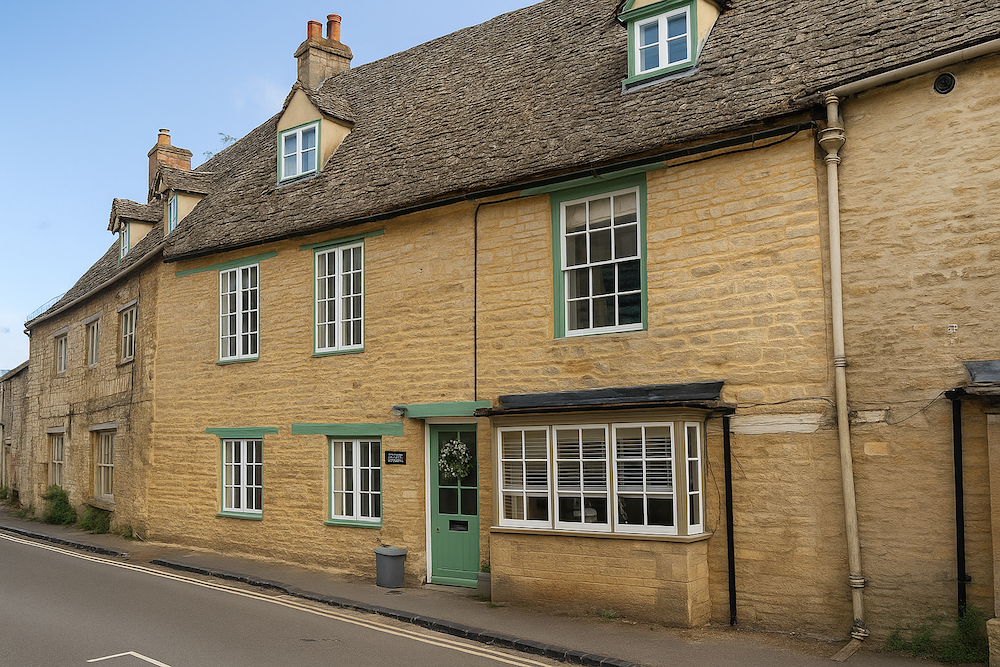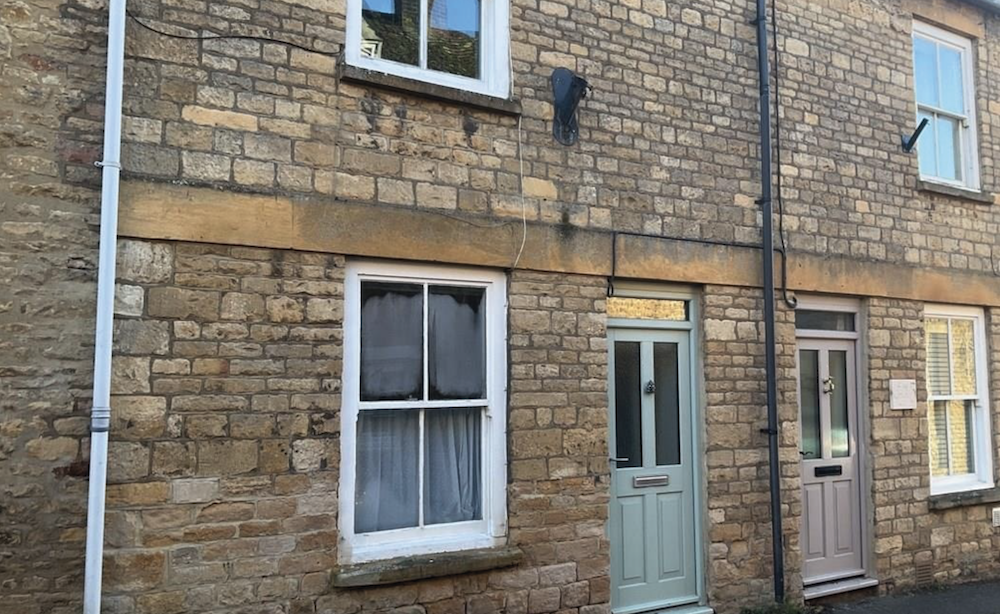
Listed pre-1900s mid-terrace home
Could your home be made warmer, cheaper to run, and better for the planet? See what’s possible when you take a whole-home approach to planning energy upgrades.
What’s the potential of a home like this?
This pre-1900s mid-terrace home in Charlbury is a listed property — typical of many historic homes in Oxfordshire. With solid and timber frame walls, solid floors, rooms in the roof, and single-glazed windows, it faced issues with heat loss, high bills, and limited upgrade options due to conservation restrictions.

The owners wanted to make improvements but were conscious of what was possible within listing rules. With a Whole House Plan, they gained a clear understanding of which measures were feasible, what materials should be used, and how best to stage upgrades over time.
Here’s what the plan revealed:
| Carbon emissions could be cut by over 90% |
| The EPC rating could rise from 60 D to 89 B |
| Annual fuel bills could fall from around £1,829 to just over £600 |
You don’t have to carry out every measure at once. The Whole House Plan gives you a roadmap so you can make improvements in your own time, at your own pace, and within your budget.

“Our house is listed so we’re restricted on what improvements we can make. The Whole House Plan laid out various measures, including their cost and the types of materials that should be used. Having this plan is going to help us going forward in planning our next steps.”
Megan, Charlbury
Where this home stands now
House profile
| EPC rating | Current 60 D > Potential 89 B |
| Type | Mid-terrace |
| Built | Pre-1900s (listed) |
| Location | Charlbury |
| Occupancy | Owner-occupied |
| Bedrooms | 3 |
| Floor area | 115m² |
| Walls | Solid and timber frame |
| Floors | Solid |
| Roof | Pitched with rooms in roof |
| Windows | Timber, single glazing with secondary glazing |
| Annual energy use | 25,560 kWh (223 kWh/m²) |
| Carbon emissions | 4.7 tonnes CO2/year |
The EPC rating: now vs potential

An EPC rates your home’s energy efficiency – from A (best) to G (worst). A higher score can mean lower bills, but it doesn’t guarantee comfort. Whole-home upgrades help bridge that gap.
Long-term comfort, short-term disruption
| Key to tables: | Low impact: • | High impact: •••••• |
| Minor measures | Comfort & health | Disruption |
|---|---|---|
| Low energy lighting | ● | ● |
| Create access to loft + add 300mm insulation | ●●●● | ●● |
| New insulated loft hatch | ●●●● | ● |
| Secondary glazing | ●●●● | ●● |
| New insulated timber front door | ●●●●● | ●● |
| Ventilation improvements | ●●●●● | ●● |
| Major measures | Comfort & health | Disruption |
|---|---|---|
| Internal wall insulation | ●●●●● | ●●● |
| Upgrade room-in-roof insulation | ●●●●● | ●●●● |
| Solid floor insulation (limecrete) | ●●●●● | ●●● |
| Air source heat pump | ●●●●●● | ●●●● |
| Measure | Comfort & health | Disruption |
|---|---|---|
| Solar PV | ● | ●● |
Expert tip

“Secondary glazing is a great way of reducing heat loss from windows that can’t be replaced. There’s a whole range of options suited to different types of window and budgets.”
Geordie Stewart, Scheme Manager
The difference each step could make
These figures show how each recommended measure could affect the home’s EPC rating, energy bills, and carbon emissions – if installed in the order shown. They’re based on a full Whole House Plan tailored to this property.
| Measure | Est. cost | EPC | Fuel bill | CO₂/year |
|---|---|---|---|---|
| Where you are now | – | 60 D | £1,829 | 4.75 t |
| Low energy lighting | £50–£100 | 61 D | £1,795 | 4.74 t |
| Loft access + 300mm insulation | £1.5k–£2k | 62 D | £1,711 | 4.49 t |
| Upgrade room-in-roof insulation | £10k–£20k | 73 C | £1,199 | 2.98 t |
| Ventilation improvements | £3.5k–£4.5k | 73 C | £1,199 | 2.98 t |
| Internal wall insulation | £14.3k–£16.9k | 76 C | £1,064 | 2.58 t |
| Solid floor insulation (limecrete) | £23k–£28k | 76 C | £1,041 | 2.52 t |
| Secondary glazing | £1.5k–£2k | 76 C | £1,035 | 2.50 t |
| New insulated timber door | £5.4k–£6.6k | 77 C | £1,024 | 2.46 t |
| Air source heat pump | £7.5k–£12.5k | 81 B | £971 | 0.55 t |
| Solar PV (2 kWp) | £3.75k–£5k | 89 B | £604 | 0.30 t |
Boost your EPC rating
Installing a single major system like a heat pump or solar panels can still make a big difference. These examples show how individual upgrades could shift the home’s EPC and reduce carbon emissions – even before doing everything else.
| Upgrade option | EPC rating | Fuel bill | CO₂ emissions |
|---|---|---|---|
| Just solar PV | 81 B | £843 | 2.73 t |
| Just heat pump | 78 C | £1,091 | 0.61 t |
| Solar + heat pump | 87 B | £722 | 0.37 t |
Expert tip

“As this is a listed property, consent from the local council will be needed before any retrofit measures are carried out. Conservation officers will ensure historic features are preserved, and that improvements such as solar panels are only added where they don’t harm the setting.”
Natasha Ginks, Retrofit Coordinator
Wondering what’s right for your home?
A Whole House Plan gives you expert, independent advice on the best steps to take – and in what order – so every upgrade really works.
Don’t put it off another year. Take the first step with a free consultation. Our team of experienced Retrofit Advisers will listen to your goals, help you understand what’s possible, and outline the best next steps – no pressure, no obligation.
Smarter home upgrades. Backed by trusted retrofit expertise.

A House Like Mine
This case study is part of A House Like Mine – a collection of real Oxfordshire homes used to model the potential of energy-saving upgrades.
Each one is based on a Whole House Plan: expert guidance on what could be done, what it might cost, and what difference it could make.
These homes haven’t had the work done – but they show what’s possible when you plan it properly.
Prefer a PDF version?
Download a shareable PDF of this case study – perfect for your community group, local class, or anyone curious about improving home energy efficiency.
We’re making this resource freely available to raise awareness of how retrofitting – upgrading your home to use less energy and stay comfortable year-round – can make a real difference.
